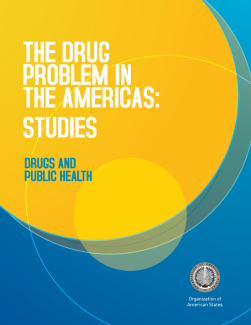The Drug Problem in the Americas: Drugs and Public Health

Summary and Findings
Most people do not use illicit drugs and among those who try them, only a fraction will develop patterns of dependence. Still, drug use constitutes a serious health problem for many people in the Americas. Early age of first use is associated with higher risk of dependence and problems. One of the greatest challenges is delaying or preventing use by young people.
Drug and alcohol use accounts for higher rates of death and disability in the Americas than as an average worldwide. It is a significant risk factor in the case of 60 illnesses or injuries from accidents and violence. Drug use in the hemisphere varies widely among countries, both in terms of the extent of use and the type of substance. This variability raises important questions—such as whether the hemisphere is facing a single drug problem or different problems, and thus what policy or policies would be most effective.
Marijuana is the most widely used illicit drug in the world, and nearly one in four users is in the Americas. While marijuana is associated with lower mortality rates than many other substances, it does present serious health risks, particularly for adolescent users whose brains are still developing.
Cocaine use is growing in parts of the hemisphere. Smokeable forms of cocaine have become a public health problem in several South American countries (Brazil, Argentina, Chile, and Uruguay), especially among the most vulnerable population groups.
Heroin consumption is much less common in Latin America and the Caribbean, with most use concentrated in the United States, Canada, and Mexico. However, it is becoming a growing concern to other countries, including Colombia and the Dominican Republic, where proven health-care approaches ought to be implemented.
Synthetic drugs such as amphetamine-type substances have high prevalence of use in Canada and the United States. Ecstasy-type substances are becoming more common among young people in many other countries in the hemisphere.
Alcohol use among high school students is a problem throughout the hemisphere, with binge drinking a particular concern. While alcohol consumption is legal for adults, any alcohol use by minors is harmful use. Epidemiological studies conducted in the Caribbean and South America concludes that in some countries, past-month use by high school students is over 50 percent.
In terms of response, school-based programs or media campaigns to prevent drug use should go hand in hand with other measures that regulate availability and involve families or tie in with community policies. That implies that the countries must give priority to this strategy, allocating needed resources for its proper implementation and evaluation.
Treatment should be provided through a continuum of care that involves every level of the health care system, with particular emphasis on early detection and brief interventions at the primary care level. All interventions should be evidence-based and of proven effectiveness. They should be run by qualified personnel and meet quality standards. Mental health is a major risk factor in the development of drug dependence, yet many countries lack adequate mental health services or sufficient trained personnel. It is therefore important to promote a sense that drug dependence is a chronic illness and must be treated as such, with full commitment from the health system and respect for patients’ rights.
Implementing and assessing effective health policies requires up-to-date information of sufficient quality and quantity; however, few countries have invested in this area. Countries need to strengthen information systems so they can properly monitor the drug problem, fund research to develop the most effective approaches, and invest in human capital and infrastructure.
In the United States and Canada, the most widely misused pharmaceuticals are opioid derivatives (used mainly as analgesics), tranquilizers and sedatives (especially benzodiazepines), and stimulants (such as methylphenidate or dextroamphetamine). The situation is murkier in the rest of the hemisphere, partly due to a lack of information correctly assessing the situation.